So, this was the big one as we painstakingly reintegrate ourselves into the ‘normal world’. Well, not really but it was our first foray into paid for accommodation, which we eased back into with a return to a lovely hotel that we had first visited in more placid terms around two years ago – The Kings Head Country Hotel at Great Bircham in Norfolk.
Ostensibly a three day break to celebrate my birthday, we ended up staying a little ahead as it was booked up on the birthday itself; in some ways reassuring as the hotel industry tries to recover from the the loss of bookings throughout much of the high season. Of course, things weren’t as before, the main adjustment the lack of daily room cleaning for the duration of the booking – perfectly reasonable and far from uncommon I understand. Other than that, breakfast and dinner service was perfectly fine, social distancing regulations in place .
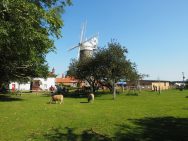
On the first morning we visited Bircham Mill. I’d prebooked this one to be sure of admission and the mill didn’t disappoint. Surprisingly busy, although the five storey mill interior was timed visit only, so we had it to ourselves for virtually the whole visit. Reassuring to note that both Mrs. No Name and I could tackle the very steep steps from floor to floor unaided. Afterwards, a walk back to the hotel and to the Bircham Stores, Deli and coffee house just opposite. Wondered before about why, in such an isolated position, an establishment loke this would be sustainable; over the course of three days, the rationale for the site became a little more evident. Excellent coffee as well and certainly not our last!
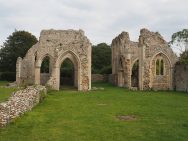
We then moved on to Creake Abbey, which has remained a tranquil spot and the attractive ruins tell the tale of the abbey’s varying fortunes. What survives are the remains of the abbey church – the presbytery, crossing, north transept and parts of the north and south chapels – while the nave survives only in the form of low walls and foundations. Set in tranquil countryside, the flint-walled ruins of this Augustinian abbey church tells a sad story of monastic disaster. After a devastating 15th-century fire, it was drastically reduced in size, with arches and windows blocked. Then plague struck, the last abbot died alone, and in 1506 the abbey closed. Not your everyday story of abbey ruination.

Next stop, Binham Abbey. Its among the most complete and impressive monastic ruins in Norfolk. This Benedictine priory was founded in 1091 by Peter des Valoines, a nephew of William the Conqueror. Many of its priors were unscrupulous and the history of the priory is one of almost continuous scandal. The nave of the priory church, with its splendid 13th century west front and fine tiers of Norman arches, is now the parish church, and displays the former rood screen with medieval saints overpainted with Protestant texts. The extensive ruins beyond emphasise the original size of the monastery. The nave of the priory church, with its splendid 13th century west front and fine tiers of Norman arches, is now the parish church, and displays the former rood screen with medieval saints overpainted with Protestant texts. The extensive ruins beyond emphasise the original size of the monastery. Well worth a complete walk round to get a sense of the scale and scope of the original monastery.
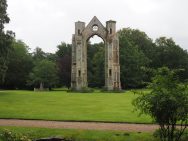
The second day started with a trip to Walsingham and a stopover at Walsingham Abbey. There is very little left of the mediaeval Priory of Lady Walsingham itself but the garden walks and Crypt interior were in themselves justification for the trip. The village looked a place worthy of a longer stopover and I personally learned a great deal about the shrine of Our Lady of Walsingham, a title of the Blessed Virgin Mary venerated by Catholics and some Anglicans associated with the Marian apparitions to Richeldis de Faverches, a pious English noblewoman, in 1061 in the village of Walsingham. Pilgrimages worldwide still very much a thing apparently. Admittedly, just the name itself increased my knowledge exponentially!!
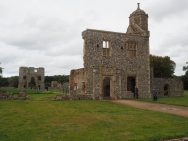
Following Walsingfield, we called in to Baconsthorpe Castle. I say called in – the entry looked and felt like a deserted farm track that hadn’t been used for years, so when we finally got there it was a bit of a shock to find a relatively full Heritage car park! The castle itself was actually a moated and fortified 15th century manor house, that was a testament to the rise and fall of a prominent Norfolk family, the Heydons. Over 200 years, successive generations of this ambitious family built, then enlarged, and finally abandoned this castle. Another typically English Heritage property and, as we are both members, no charge to us; sadly, as I think we knew, free to everyone else as well 🙂
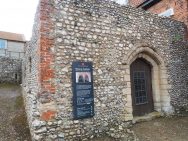
On from there to Blakeney, ostensibly to see the mediaeval Blakeney Guildhall, which to be honest was a little underwhelming. Let the photo be its own commentary. Balkeney Point however was a lovely surprise, witha gorgeous coastline and a quaint old village, although I suspect the all the quaint fishing cottages are now self catering or second homes as Blakeny residents live in the residential areas back from the coast. With well signed coastal paths and a couple of lovely looking hotels on the coast, it cries out for a more leisurely and longer return visit.
The final morning was spent in the (Great Bircham) village itself, including a visit to both the interior and exterior of St Mary the Virgin’s Church, which dates from the 12th-century, and is a Grade I listed parish building. The earliest parts of the church are the norman tower dating from ca. 1200. The tower door is 12th century and the north door and Purbeck marble font date from the 13th century. The chancel is early 14th century and the nave mid 14th century. The chancel exterior wall is covered in cement render. The 15th century screen survives.

On the exterior, tto the east of the church is a Commonwealth War Graves Cemetery for the Second World War, remembering both the airmen of RAF Bircham Newton and the German air crews who tussled with them. A plaque on the wall tells us that the Cross of Sacrifice here was the first to be erected after that war ended.
Finished with another coffee (flat white for the cognoscenti) at the local ‘Deli’ and then slowly made our way home. Coupled with our ‘vital and indispensible’ Heritage memberships, a thoroughly enjoyable break, which was also an interesting balance between taking all necessary precautions and attempting to kick start the tourism (and wider) economy. Given our age and medical history, we are understandably risk averse but we took all the appropriate precautions and never felt the least bit compromised. Still giving a wide berth to a plane tickets and foreign climes though.
